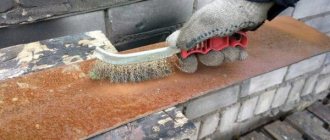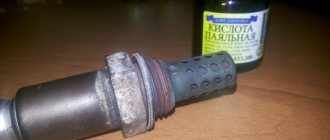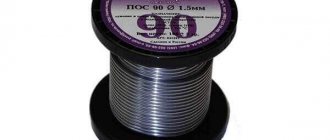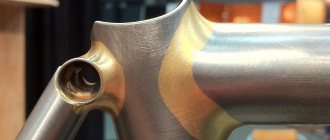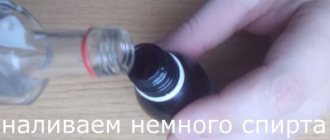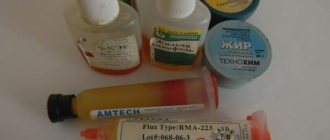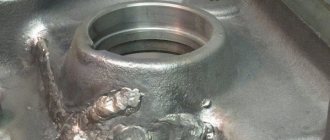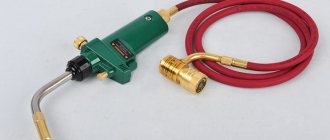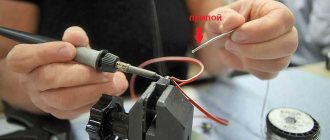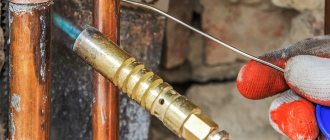In the soldering process, to eliminate all kinds of problems, such as rust or other contaminants, special substances are used - fluxes, among which phosphoric acid is in particular demand.
With its help, you can not only clean the surface of metal elements, but also provide protection against corrosion and other negative factors. Orthophosphoric acid is an inorganic substance, presented under normal conditions as colorless, hygroscopic crystals and expressed in the chemical formula H3PO4. When heated to a temperature exceeding the 213-degree threshold, the formula of the substance changes to H4P2O7, and the acid is converted into pyrophosphoric acid.
When soldering, phosphoric acid is in most cases used to fasten parts made of low-alloy or carbon steel, as well as copper. The action of this flux is aimed at dissolving the oxide film formed on the surface of the metal and solder. Under the influence of acid, this film loosens, which then rises to the surface of the flux. Next, a new protective film is formed on the cleared area, preventing the oxidation of metals. Finally, simply rinse off the remaining substance with water.
This acid is incredibly versatile because, in addition to steel and copper, it can also be used when soldering stainless steel, ferrous metals and nickel alloys. The advantage of this substance over rosin, in addition to its wide spectrum of action, is also a simpler soldering process. However, there is also a negative point: acid cannot be used when soldering contacts, since there is a high probability that it will simply corrode the material.
Classification of phosphoric acid
This substance is divided into two main groups according to the area of application:
- for the food industry. It is actively used in the manufacture of a wide variety of food products. In particular, it is used as an acidity regulator in carbonated drinks, an acidifier for traditional and processed cheeses, one of the components of the leavening agent when baking bakery products, as well as in the production of sugar, sausage and other products. On the packaging it is indicated as antioxidant E338;
- for the technical industry. In this case, we mean a wide range of applications, ranging from repair shops, where it acts as a soldering acid, to agriculture.
What is the difference between acid soldering and rosin soldering?
Some mixtures of acids provide a shiny metal surface after etching, which is not always possible to obtain if acids are used separately. Several typical compositions of acid mixtures are given below'
If droplets of water remain on the metal surface after etching, this indicates the presence of traces of grease or other contaminants on the surface that must be removed before soldering. After etching, parts should be rinsed in hot water and dried as soon as possible.
Read more:
Mechanical surface cleaning during soldering
Flux
(Latin Fluxus - flow, flow) - substances (usually a mixture) of organic and inorganic origin, intended to remove oxides from soldered surfaces, reduce surface tension, improve the spreading of liquid solder and/or protect against environmental influences [1].
Components and physicochemical properties
Orthophosphoric acid has the form of a light yellow solution or a discolored mass. The main component in the composition is zinc chloride, the share of which is at least 50 percent. According to accepted standards, the proportion of insoluble sediment should not exceed 0.001 percent of the total mass of the substance. The allowed ammonia content is within 0.5 percent.
As the formula H3PO4 shows, orthophosphoric acid is tribasic and has medium strength. When interacting with stronger acids, it shows signs of amphotericity, and the result of the reaction is the formation of phosphorite. Contact with water causes the process of electrolytic dissociation to occur.
Acid belongs to the category of substances with a fairly high degree of danger, so when working, care should be taken to prevent it from getting into the eyes and skin through the use of personal protective equipment. It should also be taken into account that due to the aggressiveness of the environment, there is a risk of a negative impact on thin parts and elements. Orthophosphoric acid demonstrates its best qualities when soldering metals with a high melting point.
What is soldering acid used for?
In this case, a hygroscopic glassy mass is formed, which, having picked up water, will turn into the same OFC. By the way, in terms of “hole-forming” activity, orthophosphoric acid is superior to sulfuric acid - water also evaporates from it and from the most dilute it becomes concentrated.
They only know the cost of these things. Toad, sir:) And rosin - it usually doesn’t need to be removed, except where microwave or high input impedance is needed. And all the other gumboils, in my opinion, are “from the evil one.” Allah knows what the Chinese mixed in with some kind of “cool” gumboil? Look, remember the story with the Fujiks...
Removing Flux
After soldering, fluxes always partially remain on the product. Flux residues spoil the appearance, change electrical conductivity, and some of them cause corrosion of the solder joint. For these reasons, after soldering, flux residues should be removed from the soldered product.
Residues of rosin and fluxes based on ethylene glycol and trithanolamine do not cause corrosion of the soldered joint and therefore cannot be removed after soldering. If flux residues spoil the appearance or interfere with the coating of the product, they can be removed by washing with alcohol or. acetone. Rosin and other non-corrosive paste-like fluxes are removed with an organic solvent or alcohol. Phosphoric and organic acids, which cause minor corrosion, are removed after soldering by rinsing with water or alcohol.
Corrosive acid fluxes containing hydrochloric acid, zinc chloride and other metal chlorides must be completely removed from the solder joint. The most thorough washing of the product in water usually does not ensure complete removal of chloride salts and chlorine ions. Critical products, especially in mass production, undergo complex processing, consisting of several operations: washing sequentially in cold and hot water, in a weak solution of caustic soda, washing in cold water, passivation in a solution of chromic anhydride and drying.
Fluxes containing borax and boric acid form a dense, water-insoluble glassy crust on the soldered seam, tightly adhered to the metal surface. The crust is removed in one of the following ways:
- The product is cooled immediately after soldering. Due to the difference in the linear expansion coefficients of the flux and the metal, the glassy crust cracks and moves away from the metal surface. This method is not always acceptable, as it can cause cracks in the metal;
- long-term boiling (5–6 hours) of the product, followed by washing in a 20% aqueous solution of chromic anhydride;
- long-term boiling in an aqueous solution of chromic anhydride (0.3–0.5 g/l);
- boiling in a hot bath (2 hours at 140 °C) containing 500–600 g/l NaOH and 200–250 g/l NaNO3;
- soaking in a 10–12% aqueous solution of potassium acid sulfate (KHSO4) at room temperature for 2 hours or in a solution heated to 40–50 deg; C for 15–30 minutes.
Specifications
| Characteristic name | Characteristic value |
| Appearance of the substance | Light yellow or colorless liquid |
| Density, g/cm³ | 1,69 |
| Solubility in water | good |
| Vapor pressure force under standard conditions, Pa | 4 |
| Content of orthophosphoric acid in the flux structure, % | 73 |
| Sulfate content, % | 0,35 |
| Amount of iron,% | 0,04 |
| Volume of heavy metals from the group of hydrogen sulfides, % | 0,001 |
| Amount of arsenic,% | 0,0005 |
| Volume of fluorine compounds, % | 0,0005 |
| Tributyl phosphate content, % | 0,0005 |
| Volume of suspended particles, % | 0,05 |
Description [edit | edit code ]
- promote better wetting of soldered parts;
- promote better spreading of solder along the seam;
- protect the metal heated during soldering from oxidation.
Soldering flux should not interact with solder, except for fluxes for reactive flux soldering. Depending on the technology, flux can be used in the form of a liquid, paste or powder. There are also solder pastes
containing particles of solder along with flux; sometimes the solder tube contains a filler flux inside. Residues of various fluxes can be both dielectrics and conduct electricity.
Examples of fluxes include:
- rosin - a mixture of resin acids and their isomers;
- ammonia (ammonium chloride, NH4Cl);
- salts, for example borax (sodium tetraborate, Na2B4O7).
- orthophosphoric acid - a solution of acid in water, from 85% or less with additives
- acetylsalicylic acid - used as an active acid flux [2]
How to choose the right acid
Phosphoric acid is considered one of the best tools when it comes to soldering parts made of low-carbon steel or other materials that are difficult to solder. As a rule, orthophosphoric acid accounts for approximately ¾ of the total mass in the flux structure. Various types of additives play a significant role, since largely thanks to them it is possible to overcome the main difficulties that arise during soldering.
There are special GOST standards that manufacturers must adhere to, but in practice this is not always the case, and the quality of the acid may vary from one supplier to another. When choosing, you should pay special attention to the presence and volume of sediment, since it negatively affects the quality of the acid itself and, as a consequence, the result of soldering.
The color of the substance is also of great importance: darker shades indicate more impurities. However, this point is not always negative, since a number of additives, on the contrary, provide improved soldering properties. However, the normal color for this acid is light yellow, and excessively dark liquids should be avoided.
Advice! Always check the expiration date of the acid before purchasing. This parameter is extremely important, since the acid shelf life is usually six months.
why do you need soldering acid?
Next: Mechanical surface cleaning during soldering
To remove grease and oil, it is recommended to use various solvents or alkaline degreasing solutions. When using a solvent, the method of condensation of a vapor of trichlorethylene solvent is used, leaving the thinnest film of sediment on the metal surface. The cold parts to be degreased are suspended over a boiling solvent. Solvent vapors condense on the surface of cold parts and flow back into the boiling liquid. Since only pure distilled solvent comes into contact with the surface of the metal being cleaned, no collateral contamination of the parts occurs. The solvent must be replaced as it becomes contaminated with oil and grease. A less satisfactory method of degreasing is to wipe the surface of the parts with a cotton cloth soaked in solvent.
In the absence of evaporating devices, a cleaning method is used by immersing parts in liquid solvents, such as trichlorethylene, methyl chloroform or cleaning liquids. The effectiveness of this method can be significantly increased using ultrasound. This method is based on the use of wave vibrations, which, thanks to the phenomenon of cavitation, help remove dirt, grease, sand or oxides.
Degreasing is often carried out in hot alkaline solutions. Typically, a 1-3% solution of trisodium phosphate or sodium silicate at a temperature of 80 ° C and above with the addition of a wetting agent is quite suitable for this purpose. Before soldering, cleaning solutions must be thoroughly removed from the surface of parts with water or steam. If water is used, it is preferable to use soft water, since hard water leaves sediments that can interfere with soldering. Fats and oils are absorbed into small cracks and pores on the metal surface (such as the pores of cast iron), and if they are not removed, they evaporate during soldering and coat the metal surface.
The described cleaning methods are intended for mass production and the question of their applicability in each individual case must be decided separately.
Pickling (acid cleaning)
The purpose of etching parts in acids is to remove rust, scale, oxides or sulfides from metals and obtain chemically clean surfaces for soldering. For these purposes, inorganic acids are used (hydrochloric, sulfuric, orthophosphoric, nitric, and hydrofluoric), taken separately or in a mixture; however, hydrochloric and sulfuric acids are most often used.
Hydrochloric acid. Technical hydrochloric acid has a specificity of 1.14 and contains about 28% by weight hydrogen chloride. For etching iron and steel in cold solutions, commercial acid is diluted in the range from 1 part acid to 2 parts water (10% HC1), to three parts acid to 1 part water (21% HC1).
Hydrochloric acid as an etchant is quite effective at room temperature and in most cases does not require heating. The temperature of the acid can increase as a result of the release of heat during a chemical reaction or as a result of immersion of heated products in it. However, the recommended acid temperature should be in the range of 29-38 °C, but not higher than 19 °C. Products not covered with scale after light annealing can be etched in 3 minutes at 29°C or in 10 minutes at a temperature of 18°C. Removing a thin layer of scale takes 15-30 minutes, a thick layer - 45 minutes or more. During operation, the concentration of acid in the solution decreases, and if the solution is not replenished with fresh acid, it will become less effective. When the iron content in the solution rises to 12%, the solution must be replaced. Sometimes an inhibitor is added to the solution to prevent corrosion of the metal after descaling. When preparing aluminum parts for soldering, in some cases a 10% HC1 solution is used.
Read also: Universal sharpening machines for cutting tools
Sulfuric acid. Sulfuric acid is produced industrially in various concentrations. A 96-98% acid has a specific gravity of 1.84, and a 77% acid has a specific gravity of 1.70. For etching, aqueous solutions containing 5-10 volume percent technical (77%) sulfuric acid are used. At temperatures below 70°, sulfuric acid is ineffective; the best results are obtained at a temperature of 82° C. Relatively clean products or products after bright annealing are immersed in the solution for 30-120 seconds, products with a thick layer of scale are etched for up to 15 minutes. The resulting black coating is washed off with water. Inhibitors added to sulfuric acid help prevent corrosion of the metal. The required solution concentration is maintained by periodic addition of fresh acid. When the acid content drops to 1%, or when the iron content increases to 8%, the solution is replaced.
Sulfuric acid is suitable for pickling steels and copper alloys. In the latter case, either 1% by weight of sodium dichromate or 2% by volume of nitric acid is added to the solution.
Orthophosphoric acid. A dilute solution of phosphoric acid (specific gravity of 100% acid 1.87) is sometimes used to pickle stainless steel and manganese bronze. Note solutions with a concentration of 10-=-40% by volume.
Hydrofluoric acid. Hydrofluoric (hydrofluoric) acid is very active and dangerous if it comes into contact with the skin. A mixture of 5% by volume hydrofluoric acid and 5% by volume etheric acid is sometimes used for pickling cast iron, high-silicon alloys and aluminum. (See Chapter 21 for safety precautions.)
Nitric acid. Concentrated nitric acid (70o/HNO3) is rarely used in its pure form. A simple and effective etchant is an aqueous solution containing 15^20% (by volume) technical nitric acid. The solution is applied cold, etching time is 2-5 minutes.
The nuances of using and soldering using phosphoric acid
Due to the fact that orthophosphoric acid belongs to the category of substances harmful to humans, when using it, compliance with safety rules and precautions comes to the fore. It must be stored exclusively in a tightly closed container, and used directly for soldering only in a room where proper ventilation can be ensured.
Be sure to ensure that you have personal protective equipment. If acid does come into contact with the skin, the area must be thoroughly washed under running water and soap.
The soldering process is generally similar to that which takes place when other types of flux are used: the metal surface is first cleaned mechanically, and only then treated with acid. Thanks to this, residual rust and other contaminants are eliminated, as a result of which the quality and reliability of the connections obtained as a result of soldering are significantly improved.
What is soldering acid used for?
Aluminum and its alloys are especially susceptible to corrosion in the presence of flux. Flux residues after soldering are removed from the surface of aluminum alloys using the following technology:
- etching in concentrated nitric acid at 18–20 °C for 5–15 min;
- rinsing in cold water for 5–10 minutes;
- etching and passivation in 10% nitric acid and 5–10% sodium dichromate solution for 5–10 minutes;
- rinsing in hot (50–80 °C) water;
- drying with a jet of hot air.
Removing flux residues after soldering is not always possible, for example, in closed joints such as honeycomb panels. In this case, it is necessary either to change the design to ensure complete neutralization of residual salts, or to abandon the flux using a protective gas atmosphere.
General information on removing flux residues after soldering is given in Table 1.
| This means that it didn’t seem to me that drops of water were visible after soldering. Thanks for the info. |
| Do not use strong drugs. And nothing will “seem”! :) |
| It’s strange but people still don’t know what Flux Remover is. such a wonderful spray can... spray and wipe off. everything remains clean and tidy. |
| Yes, they know, they know! |
| I agree. |
| Well, if it’s choking... and even a toad... buy Tsilit. it comes with orthophosphoric, citric and seemingly formic acid - the composition is written on the label. ... not for those who live near the mitten... |
| Alcohol and rosin. Alcohol with rosin. Alcohol. And the money will come in handy for me :). |
| People who have tasted zinc chloride would not exchange it for anything (ordinary soldering of components does not count!). Phosphoric acid is excellent for highly sensitive humidity sensors (ppm!). And there is still no consensus about a number of her transformations. |
| Flux type | Removal method |
| Rosin | Washing with alcohol, acetone, turpentine and other organic solvents |
| Rosin, alcohol | |
| LTI | |
| Rosin, gasoline, kerosene | Wipe with a cloth soaked in organic solvent |
| Rosin, stearin (glycerin), alcohol | |
| Glycerin, stearin, wax, fats | |
| Organic, orthophosphoric acids | Cleaning with water or alcohol |
| Rosin, hydrazine hydrochloride, alcohol, organic acids | Washing with alcohol or organic solvent |
| Triethanolamine, fluoroborates, ethylene glycol, aniline, phosphoric acid | Cleaning with warm water or alcohol |
| Ethylene glycol, hydrazine hydrochloride, alcohol | Cleaning with water or alcohol |
| Zinc chloride | Washing in acidified water followed by neutralization in a weak solution of caustic soda or rinsing in clean water, passivation in a solution of chromic anhydride |
| Zinc chloride, metal chlorides and fluorides | |
| Borax | Mechanically or by prolonged boiling in a solution of chromic anhydride and in an alkaline solution |
| Borax, boric acid | |
| Borax, boric acid, metal chlorides and fluorides | |
| Metal chlorides and fluorides | Hot water rinsing |
Read also: Is it possible to work as a hammer drill on Sunday?
LITERATURE
- Solderer's Handbook / V.E. Khryapin, A.V. Lacedaemonian. M., Mechanical Engineering, 1974, 328 p.
Classification [edit | edit code ]
According to GOST 19250-73 “Soldering fluxes. Classification", soldering fluxes are divided according to the following criteria:
- by temperature range of activity:
- low temperature (up to 450 °C);
- high temperature (over 450 °C);
- by the nature of the solvent:
- aquatic;
- non-aquatic;
- by the nature of the activator of the determining action:
- low temperature:
- rosin;
- acidic;
- halide;
- hydrazine;
- fluoroborate;
- aniline;
- stearic;
- high temperature:
- halide;
- boride-carbon dioxide;
- by mechanism of action:
- protective;
- chemical action;
- electrochemical action;
- reactive;
- according to state of aggregation:
- hard;
- liquid;
- pasty.
How to treat parts with acid
Liquid fluxes are applied to surfaces with a brush.
In this case, a more accurate and uniform wetting of the elements to be soldered is ensured, so the brush should be included in any soldering kit. At the same time, as already written above, both more active fluxes and less active ones, to one degree or another, have a destructive effect on both the connected surfaces and the solder. If the flux is not removed at the end of the work, then on steel parts, for example, rusting processes will occur at a much faster pace. To prevent this, after soldering, parts coated with flux must be treated with neutralizers. The simplest of them is water. To remove F-38 N, you don’t need to use anything other than it. Soda neutralizes well the effects of hydrochloric, orthophosphoric, and acetylsalicylic acid, as it is a base. After soldering, a soda solution should be applied to the parts, which is then washed off with water. Residues of VTS are removed with alcohol or acetone.
Soldering acid is a flux that is in a special category, since it is characterized by increased aggressiveness to the materials it works with. This substance is distributed primarily in liquid form, regardless of its concentration. Sometimes a diluted version may be sold, or a concentrated substance that you can dilute yourself. In addition, you can also try to make soldering acid with your own hands.
All properties of the material determine the scope of its application. It is intended more for heavily contaminated metals that quickly form oxides or have rust residue on the surface. Due to its high activity, the material turns out to be dangerous for contact with the skin and the surface of mucous membranes. You need to know the rules for using acid before you start working with it.
The technology for making soldering acid at home suggests that the end result should be a substance that would have properties that best comply with GOST 23178-78. This will help improve the quality of the flux to produce reliable connections. The main thing is that the properties of the acid appear even after application, since flux on the metal not only removes fatty films and oxides, but also prevents their re-formation. It is also worth noting the better spread of solder over the surface and a high level of adhesion to the base material.
Use of acid
The use of phosphoric acid is quite wide. It is worth considering the most popular methods of using it.
In medicine
It is used in dentistry during tooth filling to etch the enamel immediately before the start of the process. This procedure has its negative aspects, since it is impossible to control the depth and stage of enamel splitting, as well as their complete removal before filling. The substance remaining after such a procedure can reduce the strength of the protection and lead to the formation of acidic residues on the tooth enamel. This acid is added in small doses to tooth whiteners.
The advantage of removing rust with phosphoric acid is that it removes corrosion from the metal and creates a thin film on them, protecting them from various external influences. After covering a metal surface with this substance, an active process of corrosion and absorption of iron oxide begins. Then a gray film of an oily consistency forms on the metal plane.
There are various methods for removing oxides, among which are the following:
- with complete immersion of the element in an acid solution;
- surface treatment using a spray, brush or roller;
- coating with a solution of a mechanically pre-treated top layer of metal.
The corrosion converter is an acid solution with various additives. There are these types of solutions, depending on the additives used in their composition:
- primers;
- modifiers-stabilizers;
- rust converters.
Type 1 includes primer EVA-0112, consisting of the main component and 85% solution of the substance. It acts as a base for painting.
The Tsinkar converter contains acid and salts of manganese and zinc. When used, rust is transformed into a dense protective layer. The alloying process takes place.
Phosphoric acid for metal
To clean or solder metal elements, you must perform the following operations. Before completely immersing a metal element in an orthophosphorus composition, it is first cleaned of various types of deposits on the surface, in particular fats. To do this, wash the part using a cleaning agent. After this, it is necessary to dissolve 150 ml of the substance in 1 liter of water and immerse the metal element in this solution for 1 hour, stirring the liquid from time to time for greater efficiency.
Then you need to wash off the mixture with a solution that consists of 50% water, 2% ammonia and 48% ethanol. After this, the element must be rinsed under running water and dried well.
Before applying the spray to the surface with a roller or brush, you should first clean the surface from rust. After application, you should wait a little, and then wash off the mixture with a neutralizing solution and dry the part.
Application in agriculture
In agriculture, phosphoric acid extracted from the ore is used as a fertilizer. When it gets into the soil and then into plants, it helps them withstand drought and frost. At the same time, the soil becomes more fertile and favorable for growing vegetables and herbs.
Use of acid in everyday life and food industry
The use of acid in everyday life implies its use to remove corrosion from various surfaces (with the exception of acrylic). It is suitable for processing enamel and earthenware surfaces. Before applying the orthophosphoric acid solution, the metal surface must be treated with a detergent. To prepare the solution, mix 1 liter of water and 200 g of the active substance, and then apply the mixture to the surface to be treated for 1-12 hours. After time, the mixture must be extinguished with a soda solution and washed off.
In food production it is used as an acidity regulator.
